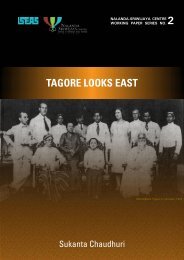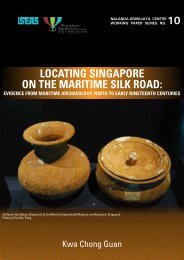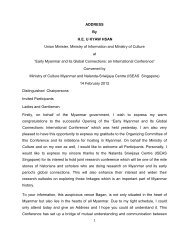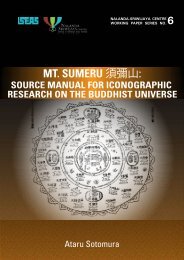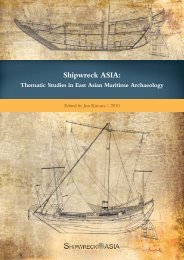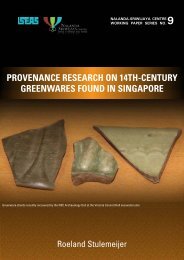Boni in Chinese Sources - Nalanda-Sriwijaya Centre - iseas
Boni in Chinese Sources - Nalanda-Sriwijaya Centre - iseas
Boni in Chinese Sources - Nalanda-Sriwijaya Centre - iseas
You also want an ePaper? Increase the reach of your titles
YUMPU automatically turns print PDFs into web optimized ePapers that Google loves.
Kurz: <strong>Boni</strong> <strong>in</strong> Ch<strong>in</strong>ese <strong>Sources</strong> NSC Work<strong>in</strong>g Paper No. 4In 1520, Huang Shengzeng 黃 省 曾 (j<strong>in</strong>shi of 1531) who hailed from Wuxian (modern daySuzhou <strong>in</strong> Jiangsu) f<strong>in</strong>ished his work on the countries that had come to the court andsubmitted tribute. Entitled Record of the Customs of the Tributaries <strong>in</strong> the Western Ocean(Xiyang chaogongdian lu 西 洋 朝 貢 典 錄 ; hereafter XCD), 142 this drew on earlier works suchas the X<strong>in</strong>gcha shenglan 星 槎 勝 覽 (1436) by Fei X<strong>in</strong> 費 信 and the Y<strong>in</strong>gyai shenglan 鷹 涯 勝 覽(1451) by Ma Huan 馬 歡 , and especially <strong>in</strong> the sections on local products that were <strong>in</strong>cluded<strong>in</strong> all entries, supplemented the earlier works <strong>in</strong> more detail.This country is situated six thousand li southwest of Zhancheng. It comprisesfourteen prefectures (zhou 洲 ). In their customs they cultivate Buddhist teach<strong>in</strong>gs(futu jiao 浮 圖 教 ), they worship statues, and they well ma<strong>in</strong>ta<strong>in</strong> fast<strong>in</strong>g. Thebuild<strong>in</strong>gs of the royal palace are covered with leaves from the Nipa palm. Thehouses of the people are [covered] with grass. The men and women [wear their hair]<strong>in</strong> a topknot, they cover their thighs with multi‐colored brocade and use floweredcotton cloth for shirts.Their customs are plenty. When they happen upon a Ch<strong>in</strong>ese on their path, who isdrunk, then they will help him return and let him sleep <strong>in</strong> their house. The climate ofthat place is cold <strong>in</strong> summer and hot <strong>in</strong> w<strong>in</strong>ter. It is rich <strong>in</strong> fish and salt. Its gra<strong>in</strong>consists of rice and sorghum. It produces sorghum liquor (shujiu 秫 酒 ), duojiangzhen多 降 真 <strong>in</strong>cense, and bee’s wax, and there are camphor and tortoise shell. Itsdefend<strong>in</strong>g locality is called “Mounta<strong>in</strong> Ever Peacefully Protect<strong>in</strong>g the Country”(changn<strong>in</strong>g zhenguo zhi shan 長 寧 鎮 國 之 山 ). (Commentary: In the sixth year of theYongle era (1408) its k<strong>in</strong>g Manarejiana 麻 那 惹 加 那 addressed the emperor: “I havebeen enfeoffed with [the title of k<strong>in</strong>g and] all the territory of my country is subject toyour adm<strong>in</strong>istration. Beh<strong>in</strong>d the country there is a mounta<strong>in</strong> and I humbly requestthat it be enfeoffed as the protector of the country.” After the k<strong>in</strong>g’s death, his sonXiawang repeated this request. Consequently it was given the present name, andthe emperor composed an <strong>in</strong>scription for a stele to be carved <strong>in</strong> stone on top of themounta<strong>in</strong>.)The country regularly sent tribute. (Commentary: In the fourth year of the Hongwuera (1370) the k<strong>in</strong>g Mamosha 馬 謨 沙 sent his official Yisimayi 亦 思 麻 逸 to present agolden memorial and a silver letter together with local products. In the third year ofthe Yongle era (1405) an envoy was dispatched from the court to enfeoff k<strong>in</strong>gManarejiananai 麻 那 惹 加 那 乃 as k<strong>in</strong>g (wang 王 ), giv<strong>in</strong>g him a seal, a tally and a titlepatent (gaom<strong>in</strong>g 誥 命 ). In the sixth year [of the Yongle era (1408)] the k<strong>in</strong>g lead<strong>in</strong>ghis consort, his family and officials to court, arrived <strong>in</strong> Fujian. A court eunuch was142 See Wolfgang Franke, An Introduction to the <strong>Sources</strong> of M<strong>in</strong>g History (Kuala Lumpur: University of MalayaPress, 1968), 221; Huang Shengzeng 黃 省 曾 , Xiyang chaogongdian lu jiaozhu 西 洋 朝 貢 典 錄 校 注 , Xie Fang 謝方 (rev. and annot.) (Beij<strong>in</strong>g: Zhonghua shudian, 2000), preface 5‐6.45





